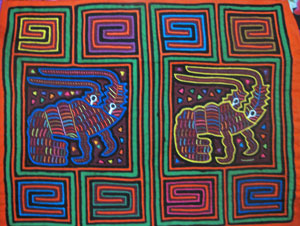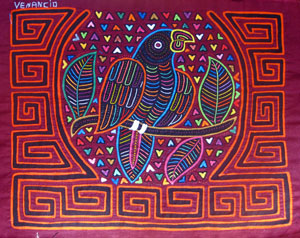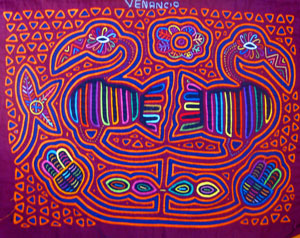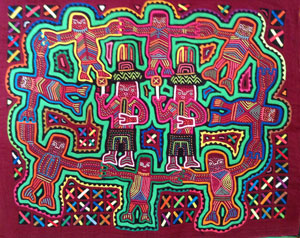Molas from Kuna Yala
The panels are exquisitely sewn of layers of cotton in reverse applique, cutting away and folding under the top layers to make the pattern. Traditional patterns tended to be geometric, red, orange, black, but over the last 80 years have branched into animal motifs and story-telling. The ones I treasure most tell the stories of Kuna myths. These works are folk art, echoes of a vanishing history, and some are masterpieces. Each panel takes several weeks to make.

Aboard I have a single child's mola, from our visit here 23 years ago.

Mola of an 6-legged octopus eating a crab.

Belasario sells me a terrific crab mola...

...and this papaya one.

Coconut palm.

A traditional design.

Mola Lisa's coral garden mola.

In this one a mystical beast assists in the brewing of chicha.

Sun and moon, an especially fine piece.

A busy lobster, appropriate Kuna Yala souvenir.

The front and back panels are intricate reverse-applique,

...related in theme and design.

Men harvesting mangoes, another finely made piece.

A flock of caged chicks.

The Kuna flag in a mola design.

Bird on a branch in a traditional pattern.

Cocoa beans, used by the shaman.

A coiled snake.

Traditional design is a map of village huts.

A pair of parrots.

A basket of avocados.

A very fine goemetric piece.

Fans.

A pair of pelicans.

Venancio told me this piloted bee (note the passengers have seatbelts) is a Kuna myth. Hovering in the upper right is an object that looks like, but is not, a helicopter, and the parachuting men may be something else as well. Kunas will weave fact and fiction together to make a pleasing design. I'd love to know the whole story of this one.

Lisa's very nice devil ray.

Some chicha dancers with hinky shoulders.

Ilfonso's sister made this very fine piece. Three figures are drinking chicha from gourds.

Venancio butterfly...

...and the matching reverse side.

Another exquisite papaya.

Medicine plants used by the shaman.

Chicha dancers encircle figures holding machachas and flutes. I love how the designer accomodated the circle perspective.

I bought this mola from Lisa in 1990.

In 2014, she shows a new work in progress, same design.
Dave asked Lisa to see a work in progress, to better understand the steps to make a mola. Lisa pulled out the one on the right. Took my breath away! This is the identical pattern to a mola I bought at Rio Sidra in 1990, apparently from Lisa!!! I showed Lisa a photo of the 1990 mola on my iPad, and she calmly acknowledged it was her design.
The new version has the background layer, and initial design cut out to be stitched on. The right right is slightly further along. Soon the topmost dark red layer will be added, cut and turned under to reveal the figures below. Two pipe-smoking women stir the chicha in pots, while seated men fan the flames. I have always considered this to be a "museum-quality" piece, the finest I am fortunate enough to own. I paid $40 back in 1990. The mola was in very good shape with fine detail, but clearly heavily worn, adding to its charm.
© Copyright 2013. All Rights Reserved.

